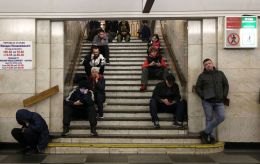Kursk breakthrough: How long Ukrainian Armed Forces stay in Russia and their goal
 Photo: Ukrainian soldier in the Suzha, Russia (Getty Images)
Photo: Ukrainian soldier in the Suzha, Russia (Getty Images)
The operation of the Armed Forces of Ukraine in the Kursk region of Russia has signs of offensive, stabilization, and peace enforcement. However, the main goal may be to create a threat to the Russian group that is attacking the north of the Kharkiv region, according to Viktor Kevliuk, an expert at the Center for Defense Strategies.
How long will Ukrainian Armed Forces stay in Russia's Kursk region
If we look at the events in the Kursk region through the Operational Art book, we see a classic example of an operation, because the number of troops involved in it fits this definition. According to the traditional definition, this is an offensive operation, but it can also have signs of stabilization and signs of peace enforcement. That is, it is a modern mix of events that does not fit into any classical canon in full.
Now we can say that the grouping of the Ukrainian Armed Forces in the Kursk region is preparing to build a defensive line along the Seym River in the west of its area of insertion. On the one hand, this will seriously complicate Russia's logistics in the east-west direction. Secondly, it will be very difficult for Russian troops to launch a counterattack to force this river, which has only three bridges. This is a very good example of using the peculiarities of the geophysical terrain.
It seems to me that we will not be going deeper into the north of the Kursk region for a very long time, and once we reach the line that the operation command considers favorable, Ukrainian troops will stop. The eastern direction, from a purely military point of view, is a way to get to the rear of the Russian group that is advancing from the Belgorod region in the Kharkiv direction under favorable conditions. This can be extremely dangerous for Russia.
Russia will need about 4 weeks just to redeploy troops to organize some kind of defensive action in the Kursk region. In addition, he also needs to create a defensive structure, build defensive lines, deploy troops, and organize command, logistics, and medicine. In the meantime, they are, so to speak, chasing their tails.
How Russians counteracting Kursk breakthrough
They are trying to stop the Ukrainian most acute breakthroughs, to protect the most critical objects for them, but they have nothing physically to create a solid defense front. Russia is pulling troops right out of the front line: in particular, two brigades have been withdrawn from the Zaporizhzhia region, and two air assault battalions have been withdrawn from the reserve from the Kherson direction. The 810th Brigade of the Black Sea Fleet, which was in the Kherson sector, and the 155th Marine Brigade, which fought near Vuhledar, ended up in the Kursk region.
From all directions, except Pokrovsk and Toretsk, Russia is withdrawing some troops and transferring them to the Kursk region. In addition, conscripts, including those drafted in the spring of 2024, are being redeployed from the territory of Russia.
This means that Russia has few free reserves. For them to maintain the pace of the offensive in the Pokrovsk and Toretsk directions, they need, first, to secure these two most promising directions. And only then decide what to do with the Kursk region. They are in a situation of strategic uncertainty. To create something in the next month, they need to decide whether to mobilize or not. They have nothing to form troops from.
The new threat in the Kursk region, and the future in the Bryansk and Belgorod regions, require the creation of a completely new group because the one that existed failed to fulfill its task. And to create new troops, you need to have someone and something to create them from. And there are big open questions for both the Russian defense industry and the Russian manning system.
Mentally, Russians are fetishists and fatalists. They need victory at any cost. They see victory at any cost in the Pokrovsk direction. They will throw all available resources into this furnace until they capture three large villages so that they can then issue an information product for domestic consumption about how strong they are. Kursk does not provide them with such opportunities. Measures will be taken to stabilize the situation there. It is not for nothing that this region is not included in the territories where a special military operation is being conducted - a counterterrorism operation regime has been introduced there.
Ukraine's goal in Kursk operation
On top of all this, we should also mention that the Kursk region has ceased to be a firing position for Russian artillery, from where they would fire on the territory of Ukraine. According to the Ukraine's General Staff's statistics, the number of Russian attacks, for example, yesterday and a month ago, has dropped significantly.
It is much more convenient to launch strikes on Russian tactical airfields in Voronezh, Lipetsk, and Kursk regions from the bridgehead in the Kursk region. Russia will be forced to pull its aircraft further to the rear. Accordingly, all this will entail a decrease in the intensity of air attacks. They will be forced to operate from long distances.
In this operation, Ukraine needs not to expand its possessions, but to establish a sanitary cordon that will guarantee peace for Ukrainian citizens in the border villages. This goal has already been achieved in some places. The depth of this cordon can vary from 20 to 100 kilometers - there is no specific standard. It depends on the means of destruction that the enemy has. Now we have secured our territory from tactical artillery and this is quite enough. The other means the enemy has been too expensive to shell sheds in the Sumy region.
From my point of view, the main goal of this operation is to create a threat to Russia's Sever group of troops, which is attacking Vovchansk, Lyptsi, and Hlyboke and trying to create problems for us in the Kharkiv region. If the military objectives of the operation outweigh the political ones, I would expect combat actions against Russia's Sever group in the Belgorod region in the coming month.
Further developments in the Kursk region will depend on Ukraine's goal. If Ukraine's goal is to create a tangible threat to the Sever group, that's one story. If Ukraine plans to launch a flanking attack and a strike from Kharkiv towards Belgorod and defeat this group, that's another story.

